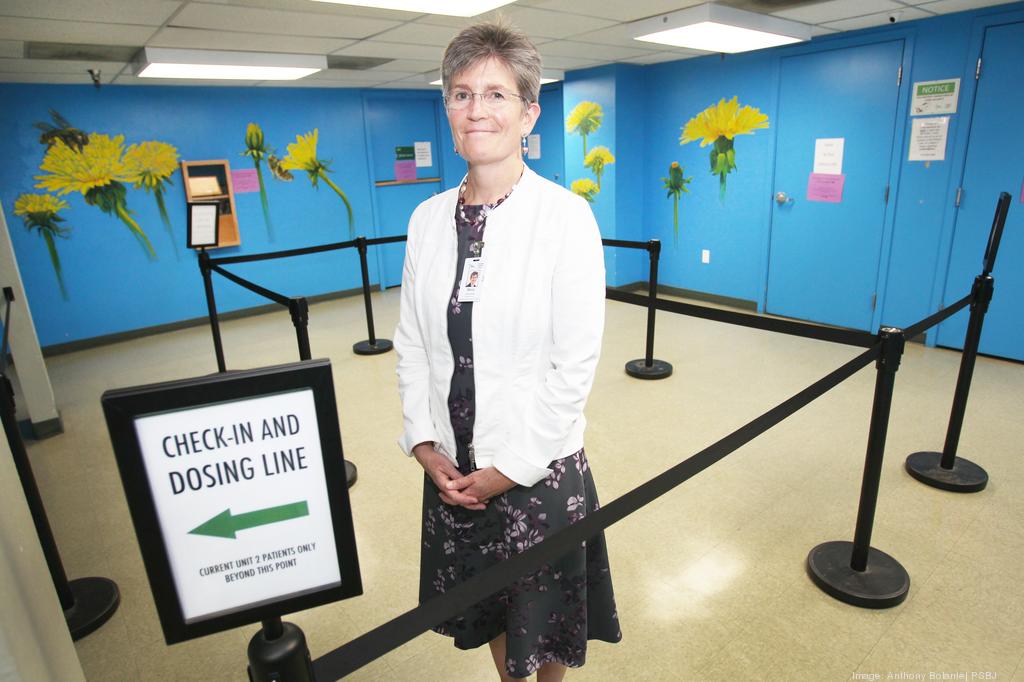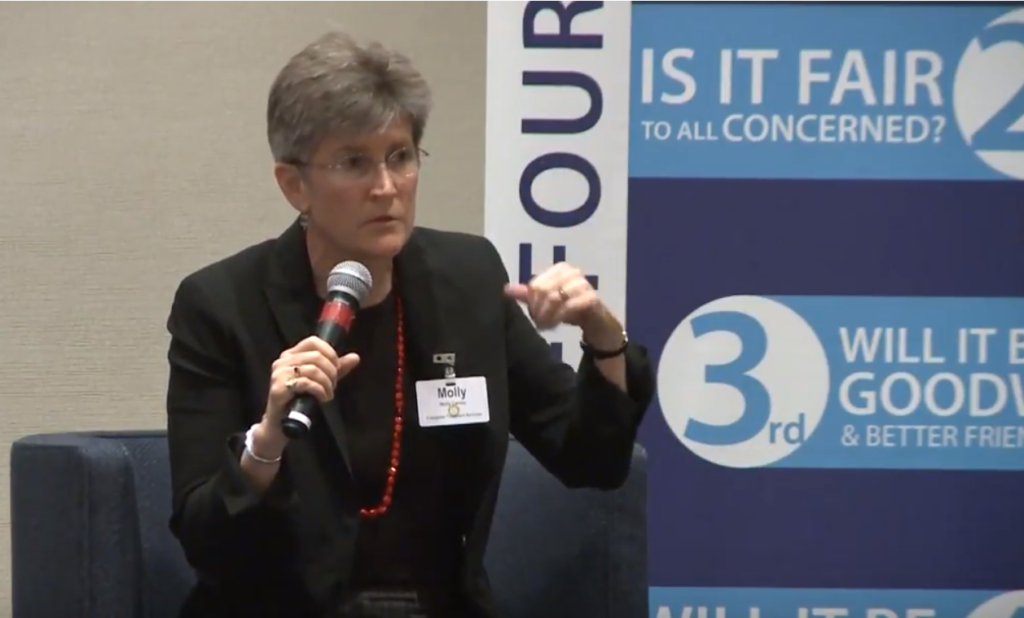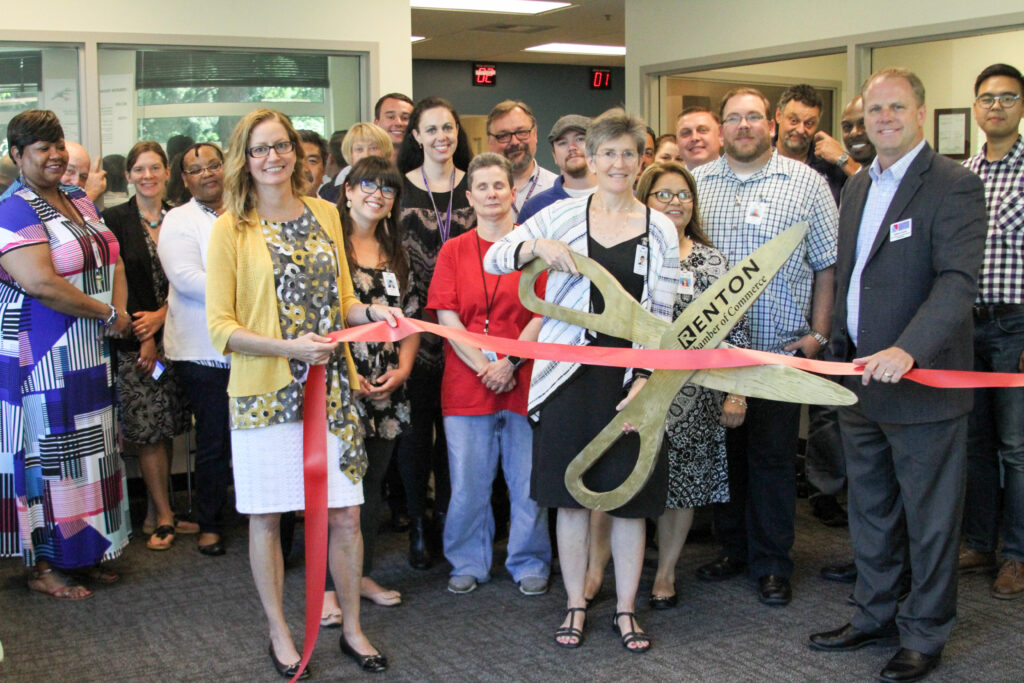
Image description: Molly Carney in dosing line at the Seattle clinic for an interview with PSBJ.
For fifty years, Evergreen Treatment Services has had the privilege of serving the greater Puget Sound community. Since first opening its doors in 1973, much has changed about ETS. But one thing has remained the same: we put the needs of those we serve first. For ETS, care is evergreen.
Molly Carney was ETS’s executive director from 2013 to 2019. She took the helm of the organization after working closely with the former executive director Ron Jackson for many years, both while at the Alcohol and Drug Abuse Institute at the University of Washington and as the director of special projects at ETS. Her tenure coincided with tremendous organizational growth and change—including increased public conversation around opioid overdose, the opening and closing of ETS clinics, homelessness, and much more.
Donate to ETS to support our life-saving work.
“Harm reduction is about working with people incrementally at a pace they’re able and wanting to work. It’s not a top-down approach where the clinician or provider knows best. Unfortunately, this top-down treatment still happens all the time in the substance use treatment industry.”
When Molly Carney started as executive director in 2013, harm reduction was not a common term ETS used to describe its clinical and social services. She called it an “underground term.” This changed throughout her time at ETS as the public recognition of the scale and tragedy of the opioid epidemic increased and the need for new, effective approaches was indisputable.
“As executive director, I had to get out into the public much more than I had anticipated. That ended up being essential for those we serve and beneficial for the agency,” Molly explained. In her role, Molly was a vocal advocate of substance use treatment, street-based homeless services, and the people who need access to them. She authored a number of opinion pieces, met with the US Surgeon General, and joined the downtown Rotary chapter with the goal of communicating with a wide range of political and business leaders. “I went from focusing on the operations and the details of what was going on inside the agency to what was influencing us from the outside. We had to position ourselves to be better recognized and better supported for the work we were doing.”
While Molly talked a lot about the harm reduction approach publicly, she did not often use the term. Because harm reduction had taken on a buzzword quality to which people often had an adverse reaction, she would instead describe the approach, why it works, and connect to people that way. This proved more effective, Molly said, “people would nod their head and understand that folks can only move as quickly as they want to move and are ready to move. You can’t force people to change.”

In many ways, Molly employed a harm reduction philosophy in her leadership style as well. When she became executive director, she met individually with many current staff so she could hear their stories and understand their perspectives on working at ETS—what made it rewarding and what could be fixed. “I knew it would be important to listen and not come in with a top-down attitude, assuming I had all the answers. Because of course I did not.” Through these conversations, Molly was able to identify key opportunities and challenges the staff faced and began to address them.
And the challenges then—as today—were many, starting with the very low Medicaid reimbursement payment system that hadn’t been adjusted in almost a decade. Because Medicaid is publicly funded, it relies on political will to maintain and to increase funding when needed. Given the stigma that exists around substance use treatment and those who need it, this was hard to come by. “This was the most disappointing thing I learned during my time at ETS—how little our society, both the public and the politicians, value the people we serve, the same people we as an organization value very much.”

Staying adequately funded was a critical point of stress for the entire span of Molly’s six-year stint as executive director, and keeping the organization afloat took up more of her time than any other challenge. “Because treatment and services that ETS provides aren’t reimbursed at a sustainable level, the staff aren’t paid enough for the tremendous work they do, and patients don’t get the resources that they need and deserve.”
Despite these gaps in financing for this critical work, ETS went through a huge expansion during Molly’s tenure because of the opioid epidemic and the explosion of regional homelessness. The organization doubled in size, added two more clinics and, at one point, was serving three times as many opioid patients as in 2013. The REACH team also significantly expanded due to the exponential increase in homelessness around the city and the amazing expertise and skill that staff has in working with homeless individuals. “It was an awful lot of growth in a very short period of time,” Molly reflected. “The reality is that our treatment and services keep people alive. So, I felt like we had to do it.” Despite the financial strain and stress on staff who had high patient and client loads, Molly was driven by the need to increase access to treatment and services for more people.
To support this growth, Molly instituted a fundraising program at ETS. While the results of the fledgling program were minimal at first, it grew to eventually support the hire of a full-time fundraising staff person, who grew ETS’s donor base and built a robust fundraising operation. ETS now holds fundraising events that draw in crowds of community members looking to ETS for solutions to the joint crises of homelessness and substance use in Seattle.
For example, this year’s Roots of Recovery fundraising event—the sixth event in ETS’s 50-year history—brought more than 400 people together and raised over $270,000. While this is a drop in the bucket compared to the costs needed for operating, the ability to garner this much support from community members who only ten years earlier actively fought to shut down a clinic development project in Bremerton, Washington is symbolic of a substantial shift in public sentiment.
When asked what one thing remains true about ETS over its 50-year history, she answered without hesitation: the dedication of ETS staff. Molly said the staff’s commitment to this work gives her hope for humanity. “If some people can care this much, perhaps it can influence others to value the people ETS serves and generate more compassion and political will to fund organizations like ETS more fully.”
Molly’s time as executive director reinforced what drew her to the position in the first place. “It’s such heart-based work and seeing what staff and patients were going through every single day was an incredible privilege and opportunity.”
Molly sees ETS as having a mandate to speak out against the systems in which the organization works, speaking truth to those in power within systems that dehumanize the people ETS serves and make it difficult to operate effectively. “It’s really about justice. It’s about social justice. It’s about health justice. It’s about privilege. It’s about communities and businesses not wanting our patients or clients nearby or visible,” Molly said.
And the solution? “We just have to keep being loud about the fact that the folks that we serve can be anybody. And regardless of who they are, they deserve our care.”




